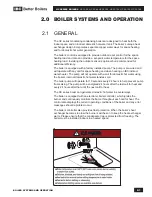
1-23
INSTALLATION
HC SERIES BOILERS
HC 13-50, HC 23-84, HC 29-106, HC 33-124, HC 20-125, HC 33-160
1.6.2 Basic Heating Piping Arrangements
PRIMARY / SECONDARY PIPING - BENEFITS AND INSTALLATION RULES
1.
Good circulating water flow through the boiler irrespective of load or radiation
system head
2.
Allows flexible ΔT° control in secondary loops
3.
Adds to the system’s thermal buffering, to assist in handling small loads and
temperature transition.
A Primary / Secondary piping configuration requires an extra pump, independant
from any secondary load pumps. The HC series modulating boiler includes the
boiler Primary Pump installed inside the boiler cabinet and is pre wired. The
pumps volute is epoxy coated to allow compatibility with the non-oxygen barrier
tubing found in some older radiant heating systems.
For optimal performance, place pumps on the supply side of secondary loops
to facilitate air evacuation. Use pumps with internal check valves to avoid ghost
flows and thermal siphoning.
The HC series boilers are designed to be piped in a Primary/Secondary piping
arrangement. In some cases the boiler can be piped in series with the heating
load if the boilers pump is capable of providing the required flow and head the
system requires. For example a HC series boiler and an IBC Air Handler series
can be installed together with out the use of an additional pump if the air handler
is installed with-in close proximity of the boiler and with properly sized supply and
return piping
Propylene Glycol mixtures of 25% - 50% are acceptable for use with-in the
boiler and piping system. In general, the use of propylene glycol will reduce the
heating capacity of the heating system and increases the pump head required for
adequate boiler flow.
If the installation involves small loads, as in typical zoned baseboard heating
applications, use of a buffer tank is recommended. To aid in temperature
transition from hot to cool loads, a 3-way mixing valve can be placed at the
entrance to the cool load (this will also provide floor protection). This will permit
immediate circulation of mixed flow into the cool loop.
See separate publication
Application Notes for more detail (available at
www.ibcboiler.com or from your
IBC Representative).
Always ensure that loads sensitive to high temperatures (e.g. radiant floor)
are protected using appropriate means such as a manual mixing valve, or an
aquastat (set to130°F, for example) wired in series with the boilers 120 VAC
power supply or connect to the X4.6 and X4.7 terminals on the boilers controller.
WARNING
Do not use automotive-type
ethylene or other types of
automotive glycol antifreeze,
or undiluted antifreeze of
any kind. This may result
in severe boiler damage. It
is the responsibility of the
Installer to ensure that glycol
solutions are formulated to
inhibit corrosion in hydronic
heating systems of mixed
materials. Improper mixtures
and chemical additives may
cause damage to ferrous and
non-ferrous components as
well as non-metallic, wetted
components, normally found
in hydronic systems. Ethylene
glycol is toxic, and may be
prohibited for use by codes
applicable to your installation
location. For environmental
and toxicity reasons, IBC
recommends only using non-
toxic propylene glycol.
Содержание HC 33-124
Страница 76: ...SERVICE RECORD DATE LICENSED CONTRACTOR DESCRIPTION OF WORK DONE...
Страница 77: ...NOTES...
















































